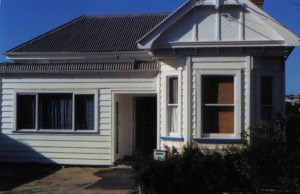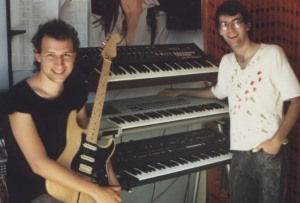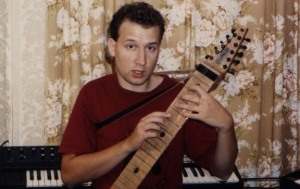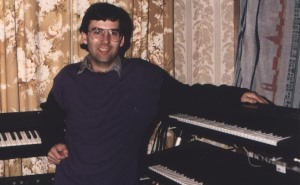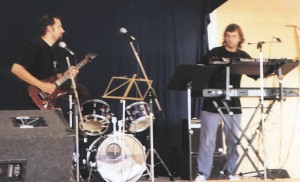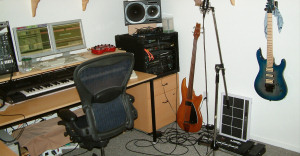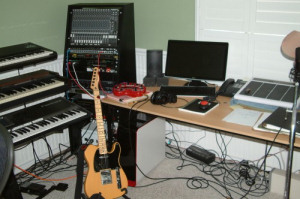Who are the Prodigal Sounds?
Let's roll the backup tape; restore the memories.
Where it all began
In the beginning of 1988, I was finishing up my final year at Auckland University whilst starting work at a "real" job. My younger brother Walter was starting his first year at Auckland Uni, so we set up a flat together with a couple of my friends.
We set up a music station in a corner of my bedroom: We had a mono mixer; a casstte tape recorder; my electric guitar; and W's Korg Polysix that he brought with him from Wellington.
1988 - 1994
Most evenings would find us jamming away on some musical ideas or listening to music. Pretty soon I was finding a use for my new disposable income, and I added a venerable Roland Jupiter 6 and a Boss stereo mixer to our "studio". By the end of the year we also added an Akai X-7000 sampling keyboard and VX90 rack synth.
We recorded everything to tape cassette. Reviewing the archives from this period, I can't believe how many ideas we generated. OK, a lot of them were kind of crappy, but there were so many of them. Musical themes that eventually found their way into Big Boys; Selling the Dragon; Painting Abstracts; and Head in the Game among them.
And then, in September 1989, I got a Korg M1, a sophisticated "workstation" sequencer with realistic sounds, drums, and a built-in sequencer... a literal "gear change" that boosted our creativity to another level. A Fostex 4-track recorder enabled us to capture even more intricate ideas than before.
By 1990, a fretless bass joined the gang, and the 4-track was upgraded to an 8-track reel-to-reel.
Our housemates changed, and so did our equipment. It was out with the Akai equipment; in with the Casio FZ1 keyboard and Korg EX8000 rack unit. Walter got a D-50; and I got a Chapman Stick.
As our skill and equipment improved, we would re-visit older tunes and record them again, trying to realise the versions of the music we could hear in our heads. I'm not sure that we had any specific goals at this point, although I was pretty sure that we would want to release this music to the world, eventually, in some form.
1994 - 1999 : Moving Apart
Real Life has a way of disrupting things. Girlfriends happened, and in some cases turned into Wives. The flat split up... Jobs changed. Without our super convenient spare-bedroom studio, we stopped working on our music.
I made contact with a performing arts student and worked on some soundtracks for his film projects: some brand-new music; and some re-purposed themes from the archives. Walter spent some weekends working on this with me.
In 1997 we rehearsed and performed three pieces at a local musicians Expo concert, organized by a cousin of ours. We used a CD backing track with pre-recorded bass and drums. Alas, we have no recording of this, our only live performance to date. (On second thoughts, maybe this is just as well.)
Then, towards the end of 1998, Real Life gave another shrug, as my wife and I made arrangements to move to California. I took a box of tape cassettes with me - the complete "archives".
1999 - 2010 : The Doldrums
My first project in 1999 was to digitally import all 22 cassette tapes on to my computer and clean them up, and burn a series of audio CDs. Although tedious, in some ways this was a pretty cool experience, listening to every version of our compositions as they changed and developed over time.
Then I put the "studio" together and started working on music again. And collecting musical instruments! Inspired by the music in the archives, I started re-recording the "classic" songs, including trying out vocals. The results were disappointing, and I put "Prodigal Sounds" on the back-burner.
Between half-hearted attempts at other projects, I kept coming back to the PS songs, reworking them with the latest studio tools, but never being satisfied with the results. In 2002 I added a Roland Fantom to the studio arsenal, to replace an aging Korg M1 which actually didn't die after all - it's still going. New instruments are often a catalyst to creativity, and this was no exception: I wrote some music in the "Prodigal Sounds" style that will hopefully end up on album #2.
Towards the end of the decade, some pretty exciting things were happening in music technology: My Digital Audio Workstation of choice - Cakewalk SONAR - was becoming frighteningly capable. I could use the built-in V-Vocal tool to pull my vocals into a shape that I could stand to listen to; the Line6 POD amplifier modeler was allowing me to capture some awesome sounding bass and guitar tracks. Virtual instruments like TruePianos and Pianoteq were doing the same for pianos and clavinets; and the Roland VK8 "virtual tonewheel" instrument was yeilding very authentic sounding "Hammond Organ" performances.
The biggest breakthrough was probably XLN Audio's Addictive Drums, one of many "virtual drum kit" instruments now available. When driven by actual drumsticks on the Roland SPD-20 pad controller, I started to create percussion tracks that I felt were worthy of the music.
2010 : The Great Reset
In 2010 I hardened my resolve. Maybe it was turning 45 years of age, and still no CD release that did it. What was stopping me? I had the track list; I had almost all the music; and by now I had all the tools to make it possible.
One thing was a vague dis-satisfaction with some of our old song lyrics. They were kind of adolescent in places. But whereas before I had nothing to replace them with, now (with the perspective of age, perhaps?) I was coming up with new ideas and themes to write about. Coming up with the title for the album was also energizing.
I created a "studio diary" web site, and made a plan: I would start at the beginning with Track 1, and either lock it down or re-record it, and move on to the next one. When I got to a track that wasn't completely written (there were a couple), I'd write it and record it. All I had to do was keep moving forward, and eventually, it would be done.
2013 : Fruit of the Steel Tree
It didn't quite work out as I described above: I confess there was some iteration back through the track list.
I kept Walter in the loop at every stage, and he approved. Eventually, three years later, Fruit of the Steel Tree was completed to our satisfaction.
And now, you can hear it too. We released the music to the public via CD Baby.
2014 - 2017 : The next thing
I've spent the last few years on other projects but I've been upgrading equipment; buying some more gear; and practising my craft by re-working several tracks but also writing new pieces of music.
In 2017 I decided to focus by releasing a "2.0" version of Steel Tree (via BandCamp), so as to concentrate on the next album.
Stay tuned...
- Colin Nicholls, November 2013


